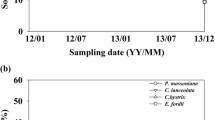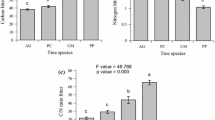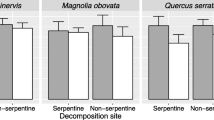Abstract
Background and aims
Invasive alien species can dramatically change the litter and organic matter decomposition rate, nutrient cycling and availability, thus threatening the ecosystem functionality. We assessed the effect of red oak (QR) introduction on low fertility well-developed soils, originally covered by Quercus robur L. (QC).
Methods
We determined litter and soil organic matter composition and decomposition rate by combining morphological features with 13C NMR spectroscopy, NaClO oxidation and soil respiration. Total and available nutrients were also determined.
Results
The sites showed different humus forms: Dysmull-Hemimoder in QC and Mor in QR. The Oi horizons had a similar composition, but the higher presence of tannins and alkyl C/O − alkyl C and aryl C/O − alkyl C ratios in QR indicated that litter was less degradable. This was confirmed by soil respiration tests, with a higher preservation of the NaClO resistant fraction along the profile, mainly due to selective accumulation of alkyl components. This was accompanied by high retention of phosphorus in the organic horizons and drastic reduction of both total and available P in the mineral horizons. Calcium was strongly affected too.
Conclusions
In these well-developed soils red oak changed organic matter dynamics, reduced P availability and cation biocycling, leading the ecosystem functionality towards a no-return threshold.





Similar content being viewed by others
References
Almendros G, Dorado J, González-Villa FJ, Blanco MJ, Lankes U (2000) 13C NMR assessment of decomposition patterns during composting of forest and shrub biomass. Soil Biol Biochem 32:793–804
Bernas B (1968) A new method for decomposition and comprehensive analysis of silicates by atomic absorption spectrometry. Anal Chem 40:1682–1686
Bernier N (1996) Altitudinal changes in humus form dynamics in a spruce forest at the montane level. Plant Soil 178:1–28
Berthrong ST, Finzi AC (2006) Amino acid cycling in three cold-temperate forests of the Northeastern USA. Soil Biol Biochem 38:861–869
Blake GR, Hartge KH (1986) Bulk density. In: Klute A (ed) Methods of Soil Analysis. Part 1, 2nd edn. Agron Monogr 9: 363–375
Bonanomi G, Incerti G, Giannino F, Mingo A, Lanzotti V, Mazzoleni S (2013) Litter quality assessed by solid state 13C NMR spectroscopy predicts decay rate better than C/N and lignin/N ratios. Soil Biol Biochem 56:40–48
Bonifacio E, Falsone G, Petrillo M (2011) Humus forms, organic matter stocks and carbon fractions in forest soils of Northwestern Italy. Biol Fertil Soil 47:555–566
Bonifacio E, Falsone G, Catoni M (2013) Influence of serpentine abundance on the vertical distribution of available elements in soils. Plant Soil 368:493–506
Brêthes A, Brun JJ, Jabiol B, Ponge JF, Toutain F (1995) Classification of forest humus forms: a French proposal. Ann Sci For 52:535–546
Bukata AR, Kyser TK (2008) Tree-ring elemental concentrations in oak do not necessarily passively record changes in bioavailability. Sci Total Environ 390:275–286
Cagnazzi B, Marchisio C (1998) Atlante climatologico del piemonte. In: precipitazioni e temperature, collana di studi climatologici in piemonte [CD]. Regione Piemonte—Università di Torino, Torino
Callaway RM, Aschehoug ET (2000) Invasive plants versus their new and old neighbors: a mechanism for exotic invasion. Science 290:521
Callaway RM, Cipollini D, Barto K, Thelen GC, Hallett SG, Prati D, Stinson K, Klironomos J (2008) Novel weapons: Invasive plant suppresses fungal mutualists in America but not in its native Europe. Ecology 89:1043–1055
Celi L, Schnitzer M, Nègre M (1997) Analysis of carboxyl groups in soil humic acids by a wet chemical method, fourier transform infrared spectrophotometry, and solution-state carbon-13 nuclear magnetic resonance. A comparative study. Soil Sci 162:189–197
Celi L, Cerli C, Turner BL, Santoni S, Bonifacio E (2013) Biogeochemical cycling of soil phosphorus during natural revegetation of Pinus sylvestris on disused sand quarries in Northwestern Russia. Plant Soil 367:121–134
Chavez-Vergara B, Merino A, Vázquez-Marrufo G, García-Oliva F (2014) Organic matter dynamics and microbial activity during decomposition of forest floor under two native neotropical oak species in a temperate deciduous forest in Mexico. Geoderma 235–236:133–145
Closset-Kopp D, Saguez R, Decocq G (2011) Differential growth patterns and fitness may explain contrasted performances of the invasive Prunus serotina in its exotic range. Biol Invasions 13:1341–1355
D’Amico ME, Bonifacio E, Zanini E (2014) Relationships between serpentine soils and vegetation in a xeric inner-Alpine environment. Plant Soil 376:11–128
Demchik MC, Sharpe WE (2000) The effect of soil nutrition, soil acidity and drought on northern red oak (Quercus rubra L.) growth and nutrition on Pennsylvania sites with high and low red oak mortality. Forest Ecol Manag 136:199–207
Dijkstra FA, Van Breemen N, Jongmans AG, Davies GR, Likens GE (2003) Calcium weathering in forested soils and the effect of different tree species. Biogeochemistry 62:253–275
Ebone A, Terzolo PG (2009) Monitoraggio, pianificazione e gestione delle specie alloctone invasive di ambienti forestali. In: Nappi P (ed) Rapporto sullo stato dell’ambiente in Piemonte 2009. ARPA-Piemonte, Torino, pp 265–267
Ehrenfeld JG, Kourtev P, Huang W (2001) Changes in soil functions following invasions of exotic understory plants in deciduous forests. Ecol Appl 11:1287–1300
Fierer N, Schimel JP, Cates RG, Zou JP (2001) Influence of balsam poplar tannin fractions on carbon and nitrogen dynamics in Alaskan taiga floodplain soils. Soil Biol Biochem 33:1827–1839
Gómez-Aparicio L, Canham CD, Martin PH (2008) Neighborhood models of the effects of the invasive Acer platanoides on tree seedling dynamics: linking impacts on communities and ecosystems. J Ecol 96:78–90
Grove S, Haubensak KA, Parker IM (2013) Direct and indirect effects of allelopathy in the soil legacy of an exotic plant invasion. Plant Ecol 213:1869–1882
Hallet RA, Hornbeck JW (1997) Foliar and soil nutrient relationships in red oak and white pine forests. Can J For Res 27:1233–1244
Janusauskaite D, Straigyte L (2011) Leaf litter decomposition differences between alien and native maple species. Baltic For 17:189–196
Jobbagy E, Jackson R (2001) The distribution of soil nutrients with depth: global patterns and the imprint of plants. Biogeochemistry 53:51–77
Kabrick JM, Dey DC, Jensen RG, Wallendorf M (2008) The role of environmental factors in oak decline and mortality in the Ozark highlands. Forest Ecol Manag 255:1409–1417
Kögel-Knabner I (2002) The macromolecular organic composition of plant and microbial residues as input to soil organic matter. Soil Biol Biochem 34:139–162
Kuo S (1996) Phosphorus. In: Bartels JM, Bigham JM (eds) Methods of soil analysis. Part 3. Chemical methods. SSSA book series Nº 5. Soil Science Society of America, Madison, pp 869–919
Lankau RA (2011) Intraspecific variation in allelochemistry determines an invasive species’ impact on soil microbial communities. Oecologia 165:453–463
Liu CJ, Westman CJ, Ilvesniemi H (2001) Matter and nutrient dynamics of pine (Pinus tabulaeformis) and oak (Quercus variabilis) litter in North China. Silva Fennica 35:3–13
Major KC, Nosko P, Kuehne C, Campbell D, Bauhus J (2013) Regeneration dynamics of non-native northern red oak (Quercus rubra L.) populations as influenced by environmental factors: a case study in managed hardwood forests of southwestern Germany. Forest Ecol Manag 291:144–153
Mehra OP, Jackson ML (1960) Iron oxide removal from soils and clays by a dithionite-citrate system buffered with sodium bicarbonate. Clay Clay Miner 9:317–327
Mikutta R, Kleber M, Torn MS, Jahn R (2006) Stabilization of soil organic matter: association with minerals or chemical recalcitrance? Biogeochemistry 77:25–56
Nicolini F, Topp W (2005) Soil properties in plantations of sessile oak (Quercus petraea) and red oak (Quercus rubra) in reclaimed lignite open-cast mines of the Rhineland. Geoderma 129:65–72
Nijjer S, Rogers WE, Siemann E (2007) Negative plant-soil feedbacks may limit persistence of an invasive tree due to rapid accumulation of soil pathogens. Proc R Soc B Biol Sci 274:2621–2627
Northup RR, Yu ZS, Dahlgren RA, Vogt KA (1995) Polyphenol control of nitrogen release from pine litter. Nature 377:227–229
Ohno T, Zibilske LM (1991) Determination of low concentrations of phosphorus in soil extracts using malachite green. Soil Sci Soc Am J 55:892–895
Preston M, Trofymow JA, Sayer BG, Niu J (1997) 13C nuclear magnetic resonance spectroscopy with cross-polarization and magic-angle spinning investigation of the proximate analysis fractions used to assess litter quality in decomposition studies. Can J Bot 75:1601–1613
Rozen A, Sobczyk T, Liszka K, Weiner J (2010) Soil faunal activity as measured by the bait-lamina test in monocultures of 14 tree species in the Siemianice common-garden experiment, Poland. Appl Soil Ecol 45:160–167
Schimel JP, VanCleve K, Cates RG, Clausen TP, Reichardt PB (1996) Effects of balsam poplar (Populus balsamifera) tannins and low molecular weight phenolics on microbial activity in taiga floodplain soil: implications for changes in N cycling during succession. Can J Bot 74:84–90
Servizio Geologico d’Italia (2012) Carta geologica d’Italia 1:50000. Foglio 155 Torino ovest. http://www.isprambiente.gov.it/Media/carg/155_TORINO_OVEST/Foglio.html. Accessed 8 April 2015
Soil Survey Staff (2014) Keys to soil taxonomy, 12th edn. USDA-Natural Resources Conservation Service, Washington
Spaccini R, Mbagwu JSC, Conte P, Piccolo A (2006) Changes of humic substances characteristics from forested to cultivated soils in Ethiopia. Geoderma 132:9–19
Staelens J, Nachtergale L, De Schrijver A, Vanhellemont M, Wuyts K, Verheyen K (2011) Spatio-temporal litterfall dynamics in a 60-year-old mixed deciduous forest. Ann For Sci 68:89–98
Talbot JM, Finzi AC (2008) Differential effects of sugar maple, red oak, and hemlock tannins on carbon and nitrogen cycling in temperate forest soils. Oecologia 155:583–592
UN/ECE ICP Forests (2006) Manual on Methods and Criteria for Harmonized Sampling, Assessment, Monitoring and Analysis of the Effects of Air Pollution on Forests. 2006 edition. part IIIa on Sampling and Analysis of Soils. Programme co-ordinating centre. http://www.icp-forests.org/pdf/Chapt_3a_2006%281%29.pdf. Accessed 8 April 2015
Van Reeuwijk LP (2002) Procedures for soil analysis. Technical paper n. 9. International Soil Reference and Information Centre, Wageningen
von Lützow M, Kögel-Knabner I, Ekschmitt K, Matzner E, Guggenberger G, Marschner B, Flessa H (2006) Stabilization of organic matter in temperate soils: mechanisms and their relevance under different soil conditions—a review. Eur J Soil Sci 57:426–445
Wardle DA, Walker LR, Bardgett RD (2004) Ecosystem properties and forest decline in contrasting long-term chronosequences. Science 305:509–513
Wedderburn ME, Carter J (1999) Litter decomposition by four functional tree types for use in silvopastoral systems. Soil Biol Biochem 31:455–461
Wilson MA, Patrick G, Hatcher G (1988) Detection of tannins in modern and fossil barks and in plant residues by high-resolution solid-state 13C nuclear magnetic resonance. Org Geochem 12:539–546
Zanella A, Tomasi M, De Siena C, Frizzera L, Jabiol B, Nicolini G (2001) Humus forestali. Manuale di ecologia per il riconoscimento e l’Interpretazione. Applicazione alle faggete. Centro di Ecologia Alpina, Trento
Acknowledgments
We thank the staff of the “La Mandria” natural park, in particular Claudio Masciavé and Giusi Rezza, for their help during field surveys.
Author information
Authors and Affiliations
Corresponding author
Additional information
Responsible Editor: Zucong Cai.
Rights and permissions
About this article
Cite this article
Bonifacio, E., Petrillo, M., Petrella, F. et al. Alien red oak affects soil organic matter cycling and nutrient availability in low-fertility well-developed soils. Plant Soil 395, 215–229 (2015). https://doi.org/10.1007/s11104-015-2555-9
Received:
Accepted:
Published:
Issue Date:
DOI: https://doi.org/10.1007/s11104-015-2555-9




